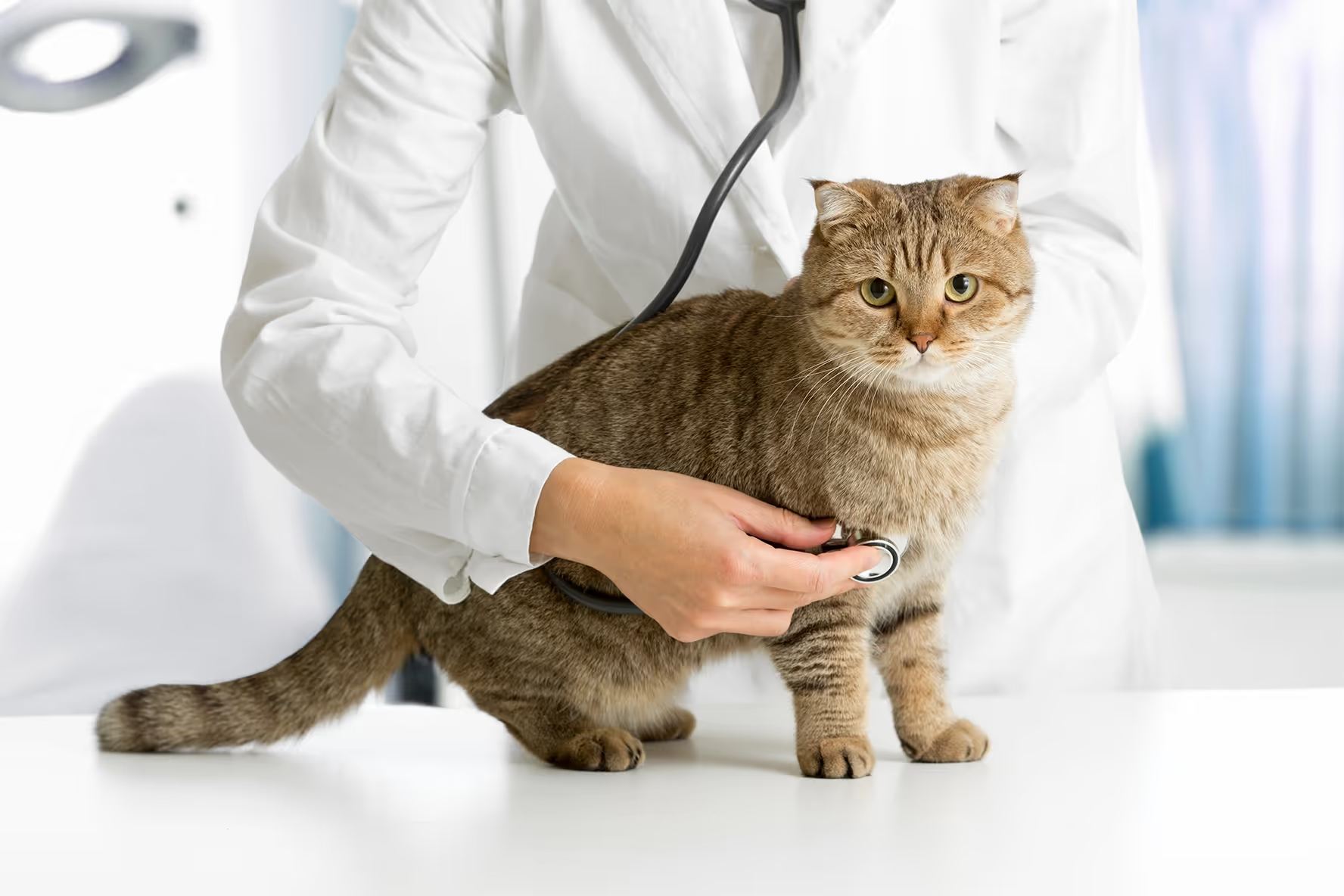
Feline lymphoma can cause symptoms like swollen lymph nodes, which may indicate the presence of this cancer. Early detection allows veterinarians to start the right tests and treatments to improve your cat’s health and outcome. By recognizing these signs early, pet owners can significantly contribute to their cat's care.
How would Lymphoma affect your cat?
Lymphoma is a type of cancer that originates in the lymphocytes, a type of white blood cell involved in the body's immune response. Specifically, lymphoma affects the lymphatic system, which is part of the body's immune system and includes lymph nodes, lymphatic vessels, spleen, and bone marrow. Lymphatic vessels are all over the body, so many parts of the body can be affected by lymphoma.3
When a cat develops lymphoma, abnormal lymphocytes begin to multiply uncontrollably, leading to the formation of tumors within the lymphatic system or other organs. These tumors can vary in size and location, and they may interfere with the normal functioning of affected organs.
The impact of lymphoma on a cat's body depends on the specific type. For example, multicentric lymphoma affects multiple lymph nodes throughout the body, leading to enlargement and dysfunction of these vital immune system structures. While alimentary lymphoma affects the gastrointestinal tract, potentially causing symptoms such as vomiting, diarrhea, and weight loss. Mediastinal lymphoma affects the chest cavity, often leading to respiratory difficulties due to compression of the airways or lungs. Extranodal lymphoma, which means lymphoma not originating in the peripheral lymph nodes, can involve organs such as the liver, kidneys, or central nervous system, which results in a range of symptoms depending on the affected organ.
Overall, lymphoma disrupts the normal function of the immune system and affected organs, leading to a variety of clinical signs and symptoms. Without a swift diagnosis and treatment, lymphoma can progress and adversely affect a cat's health and quality of life.
General signs of lymphoma
The most common symptoms a cat with lymphoma might face can often be signs that a pet parent might want to take their cat in for a check-up at the vet. While not all of these symptoms mean that your cat has lymphoma, many of them are still signs that the general wellbeing of your cat is not quite where it should be, and some support from your vet would benefit your cat greatly.4
- Enlarged lymph nodes – Swollen lymph nodes are one of the most common signs of lymphoma. These may be noticeable as lumps under the skin, particularly around the neck, behind the knees, or in the groin area.
- Decreased appetite
- Unexplained weight loss – A common sign of many diseases in cats
- Vomiting or diarrhea
- Changes in behavior – Some cats with lymphoma may exhibit changes in behavior, such as increased hiding or aggression.
- Lethargy – Sleeping more or not engaging in common activities; being less active than usual
- Difficulty breathing – Any signs of your cat struggling to breathe should raise a flag of concern and lead to a call to your vet’s office
- Increased thirst and urination – Many illnesses that cats can develop, including lymphoma, can lead to trouble with their liver, which would prompt the body to hydrate more frequently.
Symptoms of lymphoma related to the specific form of lymphoma
Alimentary lymphoma symptoms in cats
Alimentary lymphoma, also known as gastrointestinal lymphoma, affects the digestive tract, including the stomach, intestines, and associated lymph nodes. This is the most common form of lymphoma in cats. Signs that a cat might have alimentary lymphoma often mimic signs of another intestinal illnesses.1
Symptoms of alimentary lymphoma can be nonspecific and associated with the gastrointestinal track. The most common signs are weight loss, vomiting and/or diarrhea, decreased appetite, and rectal bleeding. Some behavioral signs that a pet parent may notice if the cat is very sick can include lethargy, dehydration, abdominal pain—typically leading to a cat that doesn’t want to be picked up or touched, showing signs of restlessness, or pacing.4 If you see abdominal pain, you need to have your cat evaluated as this could be a sign of intestinal obstruction secondary to a mass in the GI track. This can be a medical emergency.
Low grade alimentary lymphoma is not as aggressive and does not cause an intestinal mass. This is the most common form of GI lymphoma in cats making up 50-80% of all cases.7 These cats most often have a longer history of weight loss, decreased appetite, and sometimes vomiting and/or diarrhea. High grade lymphoma is more aggressive and can cause stomach upset signs to develop and advance more rapidly. This form of lymphoma can cause an intestinal obstruction as described above, but this is relatively uncommon to occur as other signs are present before this develops.
Multicentric lymphoma symptoms in cats
This is the most common form of lymphoma in dogs but is relatively rare in cats, accounting for approximately 4-10% of cases. Multicentric lymphoma affects multiple lymph nodes throughout the body and can also involve organs such as the liver, spleen, and bone marrow.
Symptoms of multicentric lymphoma can have a wide range as many cats feel normal but a swelling (enlarged lymph node) is noted on their neck to some cats feel ill with low energy and appetite. Signs seen at home vary widely and depend on if other organ systems are involved in the lymphoma.
Signs of Mediastinal lymphoma
Mediastinal lymphoma affects the mediastinum, which is the area in the chest between the lungs. While it is one of the less common forms of lymphoma, it can be one of the most dangerous if not treated promptly as it can severely impact your cat’s ability to breathe.
Signs of Mediastinal lymphoma include difficulty breathing, rapid breathing, coughing, open-mouth breathing, and pale or bluish gums, lips or tongue due to insufficient oxygenation.5 Should your cat experience any of these symptoms for any reason it’s important to bring them to your vet or an emergency vet as quickly as possible.
Extranodal forms of lymphoma and their symptoms
Extranodal lymphoma refers to lymphoma that occurs outside of the lymph nodes and can affect various organs or tissues in the body. This can include organs such as the liver, spleen, kidneys, skin, or central nervous system.3 The GI tract can also be a part of extranodal lymphoma.
The signs a cat might have extranodal lymphoma depend on the specific organ or tissue involved. Here are some common signs associated with different types of extranodal lymphoma in cats6:
Cutaneous Lymphoma
- Skin lesions: Cats may develop nodules, ulcers, scaly patches, or raised areas on the skin.
- Hair loss: Affected areas of the skin may become hairless or develop patches of hair loss.
- Itching or scratching: Cats may exhibit excessive grooming, scratching, or licking of affected skin areas.
- Redness or inflammation: The skin may appear red, inflamed, or irritated in areas affected by lymphoma.
Hepatic Lymphoma
- Jaundice: Cats may develop yellowing of the skin, eyes, gums, or ears due to liver involvement. (This can also happen in cats when they stop eating which causes fatty liver and can lead to jaundice.)
- Abdominal swelling: The abdomen may appear distended or swollen due to an enlarged liver.
- Vomiting: Cats with hepatic lymphoma may experience vomiting, which can be intermittent or chronic.
- Weight loss: Unexplained weight loss may occur due to decreased appetite or metabolic effects of liver dysfunction.
Renal Lymphoma
- Increased thirst and urination: Cats may drink more water than usual and urinate more frequently.
- Decreased appetite: Cats may exhibit a reduced interest in food or may refuse to eat altogether.
- Lethargy: Affected cats may appear tired or lethargic, with reduced energy levels and activity.
- Vomiting: Some cats with renal lymphoma may experience vomiting, which can be intermittent or chronic.
Ocular Lymphoma
- Eye discharge: Cats may have watery, mucous, or purulent discharge from one or both eyes.
- Redness or inflammation: The conjunctiva (the membrane lining the eyelids) may appear red, swollen, or irritated.
- Squinting or rubbing: Cats may squint, blink frequently, or rub their eyes due to discomfort or irritation.
- Vision changes: Cats may experience vision changes or abnormalities, such as cloudiness or opacity in the affected eye.
Central Nervous System (CNS) Lymphoma
- Seizures: Cats with CNS lymphoma may experience seizures, which can vary in severity and frequency.
- Behavioral changes: Cats may exhibit changes in behavior, such as disorientation, aggression, or altered mentation.
- Ataxia: Cats may have difficulty walking or coordinating movements due to neurological dysfunction.
- Head tilt: A persistent tilt of the head to one side may be observed in cats with CNS lymphoma.
These are just some examples of extranodal lymphoma manifestations in cats, and there can be variations depending on the specific organs or tissues affected. If you notice any concerning signs in your cat, it's important to consult with a veterinarian for proper diagnosis and treatment. Early detection and intervention can help improve the prognosis and quality of life for cats with extranodal lymphoma.
When in doubt, give your vet a call
If for any reason you think your cat may be showing signs that they are not feeling well, trust your gut. You are your cat's main resource for getting the help they need, and they aren’t able to communicate to you in the clearest way that something is wrong. If you notice that they are behaving differently, eating or drinking more or less, or anything else that perks up that cat-parent center of your brain, give your vet a call and let them know what changes you’ve noticed.
It may be nothing, or it may be the exact time that you need to get treatment started to save your furry friend’s life. When in doubt, it only takes a few minutes to chat with your vet to know if you should be concerned.
ImpriMed is ready to be with you on the journey if your cat is showing any of these signs
At ImpriMed, we're more than just a service – we're like a loyal friend on your cat's health journey. We're passionate about using the latest science to help your furry friend feel better.
Our new PARR and Flow Cytometry tests for cats are designed especially for them. They're super accurate and way better than older tests. The PARR test is groundbreaking because it can tell the difference between cancer cells and other cells that might look similar but aren't harmful.
So, if you're worried your cat might have lymphoma or isn't feeling quite right, we're here to help with tests that are precise and reliable, like having a trusty sidekick in your cat's healthcare adventure.
References:
- https://vcahospitals.com/know-your-pet/lymphoma-in-cats
- https://www.webmd.com/pets/cats/what-to-know-about-lymphoma-in-cats
- https://www.vet.cornell.edu/departments/cornell-feline-health-center/health-information/feline-health-topics/lymphoma
- https://www.petmd.com/cat/conditions/cancer/c_ct_lymphoma
- https://petcureoncology.com/lymphoma-in-cats/
- https://journals.sagepub.com/doi/10.1177/1098612X13483236
- Withrow and MacEwen, Small Animal Clinical Oncology, 6th edition


